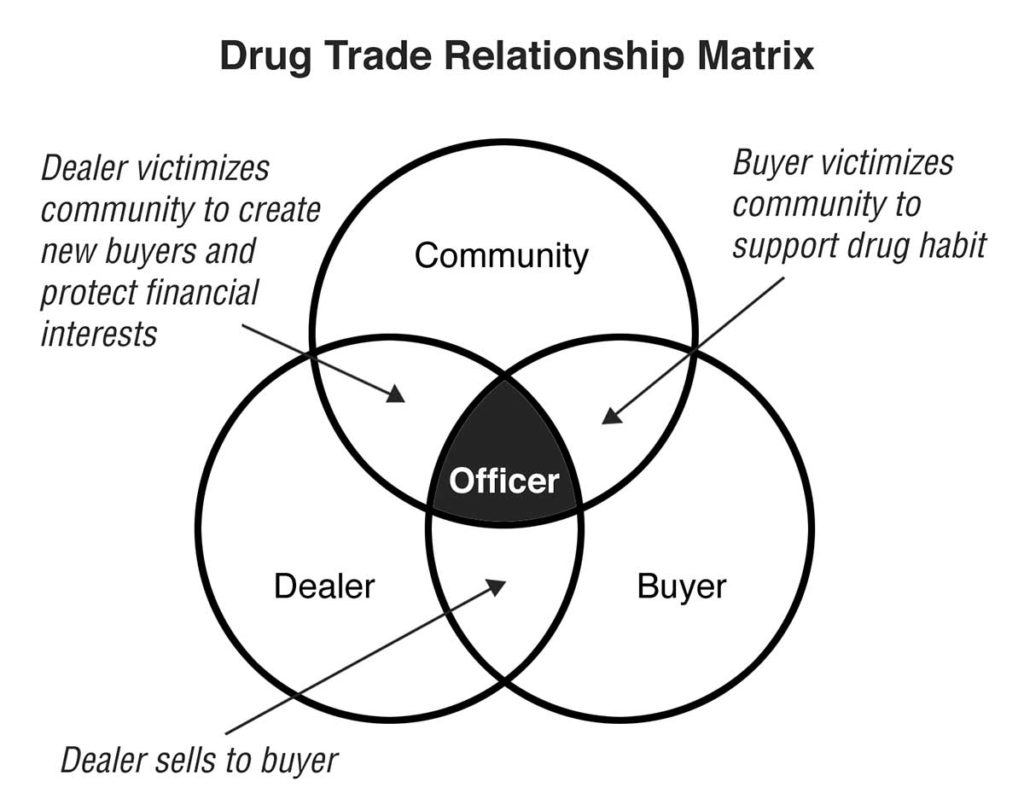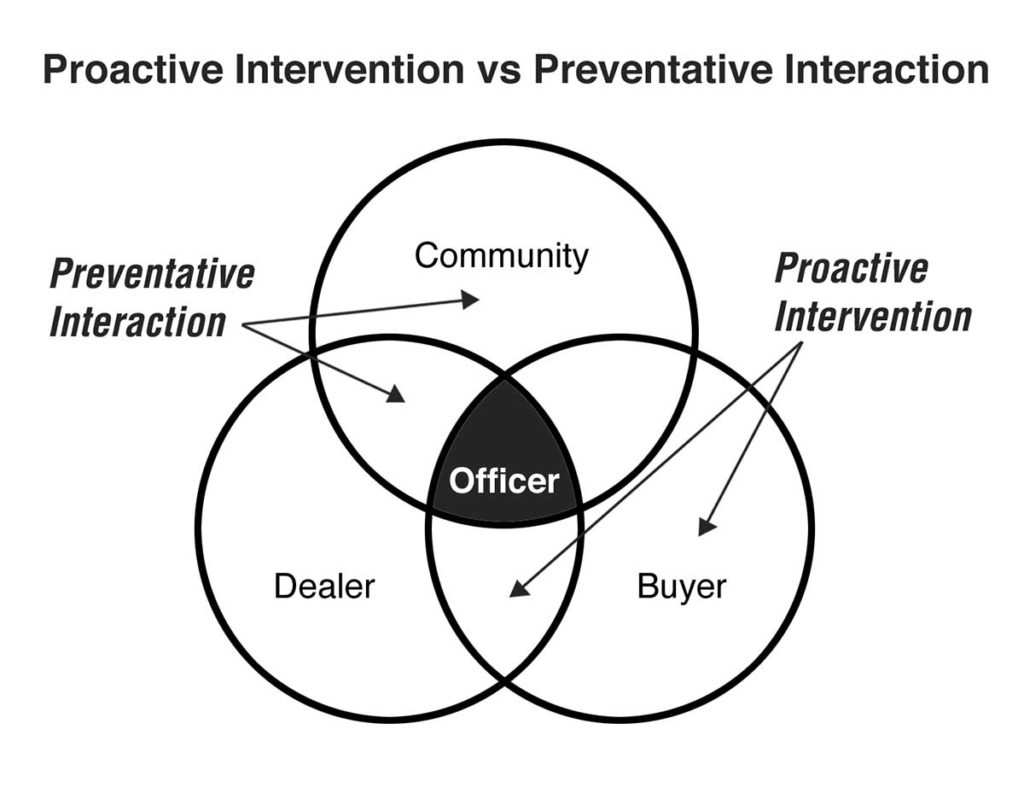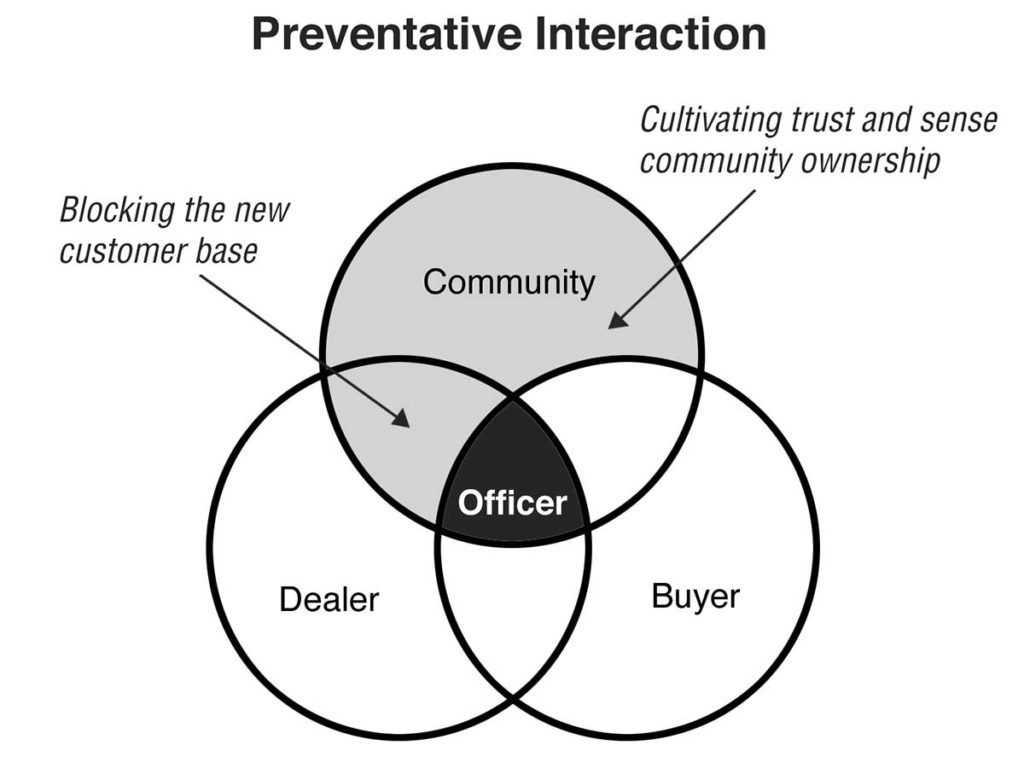In order for open narcotics sale to take place, the community must remain in a state of fear. In large, this fear is generated by criminals through the real or perceived possibility of retaliation or the threat of victimizing residents. When this fear grips the community, people become isolated and, many times, even unwilling participants in the drug trade around them. Community members will avoid confrontation and interaction with the drug dealer whenever possible, but may, when confronted, give refuge to a fleeing criminal or refuse to report the criminal to the police—simply out of fear. Often, the community becomes both the victims and the protectors of the criminal at the same time. Without the community acting in this manner, the street level narcotics dealer simply could not exist, as the dealer needs the community to conduct the business of crime.
CIS STOP team officers address the issue of community fear during the Reclamation phase of CCBPI through proactive intervention and preventative interaction with community members. Proactive Intervention involves many techniques including interference, interdiction, harassment and enforcement. Preventative Interaction, by contrast, involves communication, trust building, commitment, and caring for community members.
The dealer is at the other end of the spectrum of the community. Unlike the resident, the dealer is more than willing to get involved and fight for his self-interests, making every effort to remain in control. Unlike the community, the dealer will actually confront, provoke, and even attack when he feels that his profits are at risk. Many times s/he will do anything in order to control the community, as the community is both his protector and facilitator. The dealer also perceives the community as his customers and will struggle to maintain accessibility to his patrons.

STOP team officers in phase one intentionally focus on finding the accessibility points and act as barriers to those points (as illustrated in the chart below) by placing themselves in the center of the relationship matrix. As already discussed, the primary tactics in the reclamation deployment involve proactive intervention and preventive interaction with community members, but it also involves many other approaches that must be elaborated on further. As already stated, the relationship between the drug dealer and the community is based in control and intimidation. To break this relationship, the STOP team places relentless pressure on the drug dealer by using a wide range of tactics. While some of these tactics remain invisible to the public, many are very high profile and visible to show the community that the drug dealers are not invincible. The goal is to demonstrate through actions that the drug dealers do not control the community. As a result, the community’s fear begins to subside and the drug dealers loose their hold on the population. In essence, a wedge is driven between the community and the dealer by putting pressure on the dealers (proactive intervention) while restoring courage and ownership to the community through communication (preventative interaction).

The relationship between dealer and buyer must also be analyzed and targeted with the same focus on interruption. A key element in this relationship is accessibility. STOP team officers must focus on disrupting accessibility by creating barriers that interfere with the sale and purchase of narcotics. The weakest link in this relationship that can accomplish this is the buyer. The buyer, generally, does not instill fear in the community or fight to retain a source of financial profit. It is true that buyers often victimize communities in order to finance their drug habits through crimes such as burglary, theft, and robbery. However, the intent of the buyer is not to instill fear or control the community, but to gain the resources needed to purchase narcotics. Generally, the buyer wants to stay as inconspicuous as possible. The buyer, for most purposes, is neutral to the environment in terms of fear and control. The primary goal of the buyer is the purchase of narcotics and, subsequently, the use of narcotics at a convenient and discreet location.
When cleaning up drug activity in an area, a time will come where the officers will need to shift pressure from the dealer to the buyer. This is the only way to truly remove drug activity from an environment. When the dealer does not intimidate easily or does not want to stop selling because the customer base is too good, STOP team officers shift focus from the dealer to the customer. The objective is not necessarily to conduct arrests. Rather, the buyer is pressured out of the relationship by intimidation. Officers for example, may remain on a street corner for 8 hours in plain sight equipped with a video recorder, recording drug dealers and their buyers. At the sight of the officers with camcorders, buyers quickly leave the area for fear of identification. Again, the tactic is based on the theory that the buyer is the weakest link in the relationship and, therefore, focus must shift to the buyer to ensure success when other techniques are not completely successful. Considering the simple rules of economics, by focusing on the buyer and removing the demand, the dealer will have no other option but to relocate his/her drug sales. This same principle applies to any other business that is not capable of attracting customers. They must move, change the way they do business, or ultimately go out of business.

Another element of the relationship that exists with drug activity is the dealer’s efforts to expand his/her new customer base. A main focus of drug dealers is converting community members into customers, transitioning people from the community ring into the buyer ring. CIS officers attempt to implement barriers by utilizing proactive intervention techniques and preventative interaction with community members, specifically the children. When dealers want to create new customers, children of the area are the preferred targets. Techniques for addressing this issue are usually implemented as part of the sustained approach beginning in Phase Two of the CCBPI program.

As demonstrated in this example, by utilizing a systematic approach, STOP officers are able to insert barriers throughout the matrix and successfully disrupt the relationships between the community, the buyer, and the dealer. This approach to tailoring STOP activities to specific criminal problems is universal, applying to gangs, prostitution, and many other types of criminal activities.
Click here for more information about the CIS CCBPI strategy.
Click here for more information about Symmetry Targeted Oriented Patrolling (STOP) operations.